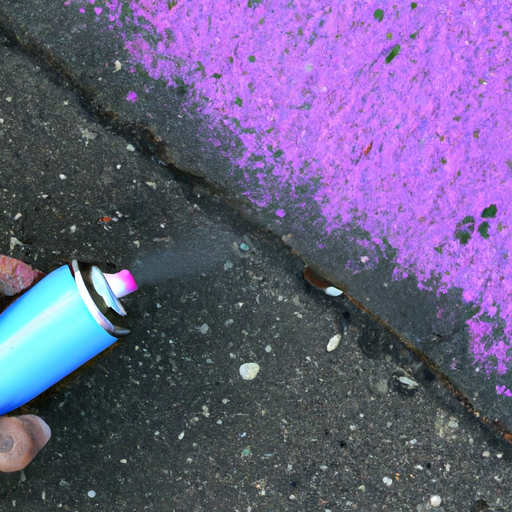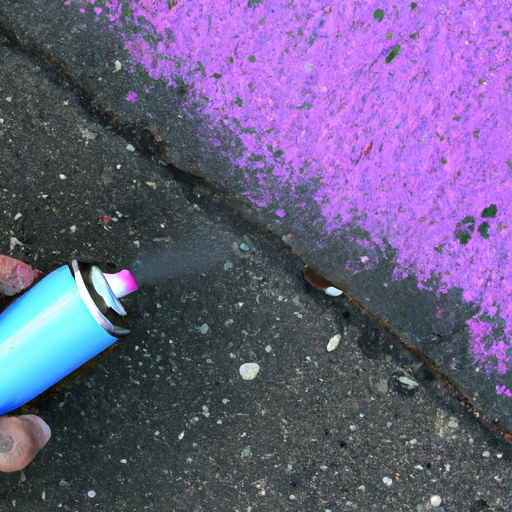Have you ever accidentally gotten spray paint on your sidewalk and wondered how to remove it? Well, fret not! In this article, you will find simple and effective methods to get rid of spray paint stains from your sidewalk. Whether it’s a recent mishap or a lingering mark, these techniques will help you restore your sidewalk’s pristine condition in no time. So, let’s jump right in and discover how to say goodbye to those pesky spray paint stains and make your sidewalk look as good as new!

Preparation
Before you begin the process of removing spray paint from your sidewalk, it’s important to gather the necessary materials. You will need items such as baking soda, water, vinegar, hydrogen peroxide, acetone, nail polish remover, paint thinner, a power washer or pressure washer, sandblasting equipment, chemical stripper, a wire brush, and sandpaper. Make sure you have all these items readily available to ensure a smooth and efficient cleaning process.
Choosing a suitable time is also crucial when attempting to remove spray paint from your sidewalk. Pick a day when the weather is clear and dry, as this will help to optimize the effectiveness of the cleaning methods you choose. Additionally, choose a time when foot traffic on the sidewalk is minimal to avoid any accidental contact with the cleaning solutions.
Before you begin any cleaning methods, take the time to inspect the sidewalk thoroughly. Look for any cracks or damages that may require special attention. It’s important to address any underlying issues before starting the cleaning process to prevent further damage to the sidewalk.
Using Common Household Products
One of the simplest and most accessible methods for removing spray paint from a sidewalk is to utilize baking soda and water. Create a paste by mixing baking soda with water until you achieve a thick consistency. Apply the paste to the spray paint stains and gently scrub the area using a scrub brush or sponge. Rinse with water and repeat the process if necessary.
Vinegar can also be an effective cleaning agent for removing spray paint. Apply vinegar to the spray paint stains and let it sit for a few minutes to allow the acid in the vinegar to break down the paint. Afterward, scrub the area with a brush or sponge, then rinse with water. This method may require a bit more effort, but it can be quite effective.
Another common household product that can help with spray paint removal is hydrogen peroxide. Apply hydrogen peroxide to the spray paint stains and let it sit for a few minutes. Then, scrub the area with a brush or sponge and rinse with water. The hydrogen peroxide will help to lift the paint off the sidewalk.
Using Stronger Chemicals
If the common household product methods do not fully remove the spray paint, you can consider using stronger chemicals such as acetone. Acetone is a powerful solvent that can effectively dissolve paint. However, it is important to exercise caution and follow safety guidelines when using acetone. Apply a small amount to a clean cloth or sponge and gently rub the spray paint stains. Rinse with water afterward to remove any residue.
Nail polish remover, which typically contains acetone, can also be effective in removing spray paint. Apply nail polish remover to a clean cloth or sponge and gently rub the spray paint stains. Be sure to rinse with water after removing the paint.
Paint thinner is another option to consider for spray paint removal. Apply a small amount to a clean cloth or sponge and gently rub the affected area. Rinse with water to remove any residue.
It is important to note that when using stronger chemicals, proper ventilation and protective gear should be used to ensure personal safety. Additionally, always follow the instructions on the product labels and test the chemicals on a small, inconspicuous area of the sidewalk before applying them to larger areas.
Power Washing
Power washing can be an effective method for removing spray paint from your sidewalk. You can either rent or purchase a power washer, depending on your preference and the frequency of use. When using a power washer, it is crucial to prepare the area properly. Remove any loose debris, dirt, or leaves from the sidewalk. Cover nearby plants or objects that could be potentially damaged by the force of the water.
When operating a power washer, it is important to follow correct power washing techniques to achieve the best results. Hold the spray nozzle at a slight angle and maintain a consistent distance from the pavement. Start with a low-pressure setting and gradually increase as needed to avoid damaging the sidewalk. Move the nozzle in a sweeping motion to evenly distribute the spray and remove the spray paint effectively.

Using Sandblasting
Sandblasting involves using a high-pressure stream of sand to remove spray paint from the sidewalk. It is important to understand the process and associated risks before attempting this method. Sandblasting can cause damage to the sidewalk surface if not done correctly, so it may be best to consider hiring professionals who are experienced in this technique.
If you decide to undertake sandblasting yourself, you will need the appropriate equipment. This includes a sandblasting machine or gun, sand or abrasive material, and protective gear such as goggles and a mask. Be sure to carefully follow all safety guidelines and instructions for proper usage.
Hiring professionals for sandblasting can provide peace of mind, as they have the necessary expertise and equipment to complete the job safely and effectively. Research local sandblasting companies and request quotes to determine the best option for your specific situation.
Pressure Washing
Similar to power washing, pressure washing can be an effective method for removing spray paint from your sidewalk. Renting or purchasing a pressure washer will allow you to tackle the task at hand. As with power washing, proper preparation of the area is essential. Remove any loose debris and cover nearby plants or objects that may be susceptible to damage.
When using a pressure washer, it is important to follow correct pressure washing techniques. Hold the spray nozzle at a slight angle and maintain a consistent distance from the pavement. Start with a low-pressure setting and gradually increase as needed. Move the nozzle in a sweeping motion to ensure even removal of the spray paint.

Chemical Stripping
Chemical stripping involves using a specialized chemical product to dissolve the spray paint from the sidewalk. Before starting this method, it is important to choose the appropriate chemical stripper for the type of paint used and the composition of the sidewalk. Read the product labels carefully and follow all safety instructions.
Apply the chemical stripper according to the manufacturer’s instructions, ensuring that you wear protective gear such as gloves and goggles. Allow the stripper to sit for the recommended amount of time to allow it to penetrate the paint. Use a clean cloth or brush to scrub the area and remove the paint. Rinse the sidewalk thoroughly with water afterward to remove any residue.
Assess the results after using the chemical stripper. If necessary, repeat the application and scrubbing process until the spray paint is fully removed. It is important to note that chemical stripping can potentially cause damage to the sidewalk surface, so it should be done with caution.
Using a Wire Brush
A wire brush can be an effective tool for removing spray paint from a sidewalk. Select a suitable wire brush with stiff bristles to effectively scrub the paint off the surface. Begin by gently scrubbing the spray paint stains using circular motions. Apply some pressure but avoid scratching or damaging the sidewalk. Rinse the area with water to remove any loosened paint or debris.
After removing the spray paint with the wire brush, finish with a thorough cleaning of the sidewalk. This can be done using a broom or a hose to remove any remaining residue or dirt.

Buffing with Sandpaper
If the spray paint stains are stubborn and resistant to other cleaning methods, using sandpaper can be a viable option. Choose the right sandpaper grit depending on the severity of the paint stains. Start with a coarser grit, such as 80 or 100, to remove the majority of the paint. Then, switch to a finer grit, such as 200 or 400, to smooth out the surface and remove any remaining traces of paint.
Rub the spray paint gently with the sandpaper, applying even pressure. Be careful not to apply too much pressure, as this may cause damage to the sidewalk surface. Afterward, clean the area thoroughly to remove any debris or dust.
Seeking Professional Help
If all else fails or if you prefer to leave the job to professionals, there are several avenues to explore. Consider contacting a professional cleaning service that specializes in removing graffiti or spray paint from various surfaces. They have the knowledge, experience, and equipment to handle the job efficiently.
Research specialized graffiti removal companies that specifically focus on removing spray paint from sidewalks and other public areas. These companies often employ advanced technologies and methods to effectively remove the paint while minimizing damage to the surface.
Another option is to hire a pressure washing company. These companies specialize in deep cleaning and can utilize high-pressure techniques to remove the spray paint from your sidewalk. Research local pressure washing services, read reviews, and request quotes to find the best fit for your needs.
In conclusion, removing spray paint from a sidewalk may require different methods depending on the severity of the stains and the type of surface. It is important to properly prepare the area, gather the necessary materials, and follow the correct techniques for each method. Whether you choose to utilize common household products, stronger chemicals, power washing, sandblasting, wire brushing, buffing with sandpaper, or seek professional help, there are various options available to restore your sidewalk to its original clean state.




